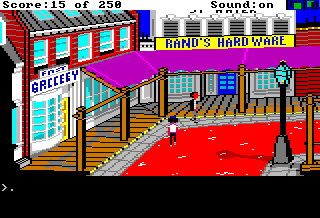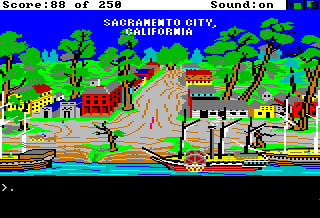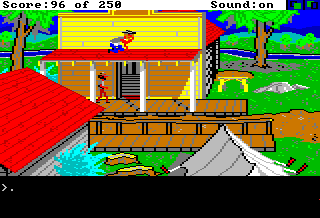|
 n
1848, men from all over the world headed for California
in the hope of making a fortune. As Jerrod Wilson, you
are one such man. Jerrod lives a humdrum life as a newspaper
reporter in Brooklyn Heights, New York. But when be
hears rumours of gold, he's determined to get in on
the excitement and the money. His brother Jake disappeared
some years ago and every day Jerrod visits the post
office in the hope of a letter from his long-lost brother. n
1848, men from all over the world headed for California
in the hope of making a fortune. As Jerrod Wilson, you
are one such man. Jerrod lives a humdrum life as a newspaper
reporter in Brooklyn Heights, New York. But when be
hears rumours of gold, he's determined to get in on
the excitement and the money. His brother Jake disappeared
some years ago and every day Jerrod visits the post
office in the hope of a letter from his long-lost brother.
This
seems like another ordinary day, people going about
their usual business, but maybe if Jerrod takes a look
inside that post office, he'll have a surprise. Brother
Jake is not dead as feared but instead is in California.
The letter he sends to Jerrod reveals (in not very subtle
code) that he has discovered gold and wishes Jerrod
to join him in the Golden State.

Crikey,
that jovial Geordie gets everywhere!
If
you can get to California, you could get rich, but it's
2500 miles away and Concorde hasn't yet been invented.
There are three main travelling options: by ship --
either going round the infamous Cape Horn, or by landing
in Panama and travelling through the jungle (the canal
hasn't been built yet) to another ship. The third option
is to take the stagecoach to Independence, Missouri,
where you join a mining company travelling westward
in wagons.
Before
you embark on any of the dangerous journeys, you must
get enough money for the ticket. Selling your house
is the way to make big money, but if you wait too long
the rumours of Californian gold will cause property
prices to drop and ticket prices to rise. The estate
agent doesn't have an office, but comes round to buy
your house when you've stuck a 'For Sale' sign in the
front garden (achieved by typing SELL HOUSE).

Relaxing
on the boat trip to California
A
joystick, mouse or cursor keys may be used to make Jerrod
walk around the 3-D landscape of Brooklyn. Talking to
other characters is achieved by 'TALK TO person', and
interaction is limited to listening to their messages.
Shops can be entered in order to buy useful equipment
and food. Strangely, you can't pay shopkeepers any money
(you decide to 'save it for a rainy day') but they will
allow you to have three items on your account. What
you choose depends on which way you plan to reach California.
For example, if you're going by ship some citrus fruit
will prevent you getting scurvy.

As
with most Sierra adventures, Gold Rush hardly
makes use of the Amiga's graphics and sound capabilities.
Some of the scenery is well drawn but the characters,
although realistically animated, are blocky and have
bright red faces (perhaps they're embarrassed by their
appearance!). Even so, Brooklyn Heights bustles with
animated people and horse-drawn carriages. The only
problem is that when three or four characters are on-screen
simultaneously, their movement is slowed down to a snail's
pace. Sound is limited to the sort of 'beepy' tunes
associated with the Spectrum (Shock! Horror!). But after
a while the simple presentation goes unnoticed, as you
get caught up in the excitement of 'gold fever'. The
game manages to capture the authentic atmosphere of
the time, helped by the fact that it is geographically
and historically correct.

After
setting off for California, frequent saving of the game
position is a necessity as there are many ways to die,
ranging from cholera and starvation to sinking (on the
ship, of course!). Dying frequently can become irritating
(as my zombie uncle Trevor keeps telling me), but somehow
the lure of all that gold makes you persevere. And if
you get totally stuck, you can read the fascinating
96-page historical guide (included in the packaging),
to see how the real 49ers managed. (They won the Superbowl,
didn't they?! - Ed). Ultimately, how much enjoyment
you get out of Gold Rush depends on whether you
love or loathe the Sierra 3-D adventure style -- if
you're a fan, you shouldn't be disappointed.
|